Since 2014, ISIS has demonized, threatened and persecuted religious minorities. This report explores the ideological justifications for ISIS’s violent campaign to target—and ultimately eliminate—other religious communities.
Executive Summary
The fact is that [ISIS] kills Christians because they are Christians; Yazidis because they are Yazidis; Shia because they are Shia.Former U.S. Secretary of State John Kerry, March 17, 2016.
On March 15, 2016, the U.S. House of Representatives unanimously voted to classify ISIS’s actions targeting religious minorities in the so-called Islamic State as war crimes, crimes against humanity, and acts of genocide. Two days later, then U.S. Secretary of State John Kerry confirmed that ISIS “kills Christians because they are Christians; Yazidis because they are Yazidis; [and] Shia because they are Shia.” As the former Secretary said, ISIS’s “entire worldview is based on eliminating those who do not subscribe to its perverse ideology.” (Sources: Christianity Today, U.S. Department of State)
As ISIS targets religious minorities within its held territory, the group also calls for attacks against Christians, so-called apostates, Jews, and Hindus worldwide. One article from ISIS’s online English-language magazine Dabiq declared that the militant group rejects any religion that does not parallel its own extremist brand of Sunni Islam. “We hate you,” the article directed at its secular readers, “first and foremost, because you are disbelievers; you reject the oneness of Allah – whether you realize it or not.” (Sources: Dabiq, Daily Mail, Dabiq, Firstpost, Independent)
CEP’s ISIS’s Persecution of Religions report highlights ISIS’s ongoing use of genocidal violence and incendiary rhetoric against Muslims, religious minorities, and members of other religions and faith groups.
Directly Targeted by ISIS
Hundreds of thousands of Yazidis, Christians, and Mandaeans in Iraq and Syria have been displaced, killed, kidnapped, raped, and tortured by ISIS militants. ISIS’s treatment of these minorities has been characterized by the international community as genocide and crimes against humanity.
Yazidis
No other religious group present in ISIS-controlled areas in Syria and Iraq has been subjected to the destruction that the Yazidis have suffered.U.N. Human Rights Council, June 15, 2016.
According to a June 2016 report by the United Nations, more than 400,000 Yazidis have been displaced, captured, or killed since August 2014, when ISIS launched a deadly siege on Yazidis in Mount Sinjar. According to a 2016 report by the U.N. High Commissioner for Human Rights, “no other religious group” in ISIS-controlled areas “has been subjected to the destruction that the Yazidis have suffered.” (Sources: United Nations, Guardian)
Yazidis, who practice a combination of Zoroastrianism, Mithraism, and Islam, have long been ostracized and accused of devil-worship by some Muslim populations in the Levant, due to perceived similarities between the Yazidi angel Tawusi Melek and the Islamic devil Shaytan. Prior to ISIS’s rise to power, the majority of the global Yazidi population lived in northern Iraq, in and around the Sinjar Mountains. As of June 2016, the United Nations notes that “no free Yazidis remained in the Sinjar region.” (Sources: United Nations, New York Times, VICE News, Atlantic, Daily Mail, National Geographic)
ISIS’s Territory
On August 3, 2014, ISIS attacked and conquered the town of Sinjar in Iraq’s northern Nineveh province. ISIS swept through the city, killing nearly 5,000 Yazidis, capturing 6,300 more, and forcing 400,000 to flee to Turkey and Iraqi Kurdistan. An estimated 55,000 Yazidis fled into the nearby Sinjar Mountains, where dozens subsequently died from dehydration and starvation. Although thousands of Yazidis have escaped, an estimated 2,000 remain trapped in the foothills, waiting for the ISIS militants nearby to be purged from the region. (Sources: United Nations, Guardian, Al Jazeera, Star, Guardian, CNN, BBC News, VICE News, New York Times)
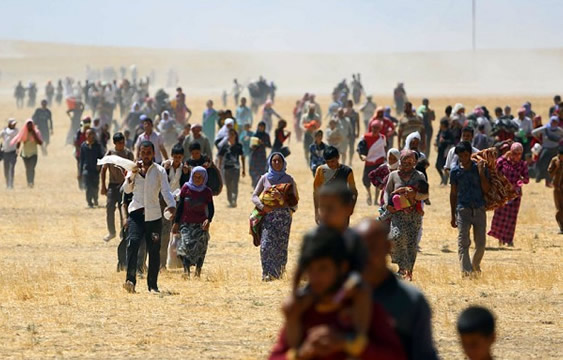
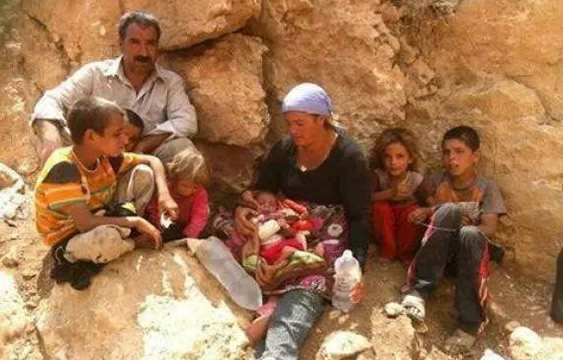
Today, out of more than 6,300 Yazidis captured during the siege, an estimated 3,500 are still being held captive by ISIS, the majority of them women. ISIS has traded hundreds of Yazidi women and girls—some as young as nine years old—as sex slaves in its auctions. Former Yazidi captives have said they would be tortured if they resisted the sexual advances of ISIS fighters and that suicides and suicide attempts are commonplace among female captives. In April 2017, one Kurdish official noted that the bodies of between 1,300 and 1,500 Yazidis were found near Sinjar since ISIS began terrorizing the region. (Sources: India Today, Guardian, New York Times, VICE News, United Nations, Yahoo News, New York Times, CNN, Daily Mail, CNN)
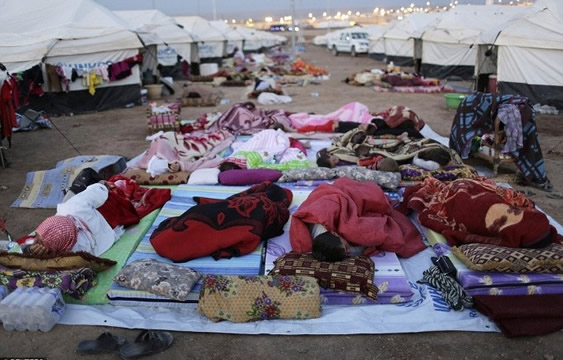
ISIS has sought to defend its actions toward Yazidis through its online propaganda magazine Dabiq. One article from the magazine’s October 2014 issue claimed that “enslaving the families of the [non-believers] and taking their women as concubines” was a “firmly established aspect” of sharia (Islamic canonical law). ISIS has used its platform online to further demonize Yazidis, labeling them as “devil worshippers,” “pagans,” and “infidels.” (Sources: Dabiq, Reuters, Atlantic, CNN)
Christians
ISIS militants have tortured, raped, kidnapped, and executed Christians in Iraq and Syria, despite claiming that Christians who pay a special tax (jizya) would receive ISIS’s protection. According to a July 2016 report by the Hudson Institute, ISIS’s jizya option is a deceptive propaganda ploy used to extort Christians with no regard for their protection or religious freedom. The group urges attacks on Christians outside of its territorial strongholds. (Source: Hudson Institute)
ISIS’s Territory
On June 10, 2014, ISIS captured the Iraqi city of Mosul, demanding that all of the city’s Christian inhabitants pay jizya and live as second-class citizens. Two days later, however, ISIS reneged on this promise of security, instead saying that Christians would be killed or forced to convert to Islam if they did not leave Mosul by the following week. Similar policies were implemented through the rest of Iraq’s northern Nineveh Province. Syrian Catholic leader Ignatius Yousef Younan from Nineveh claimed that at least 500 Christians from his diocese were killed by the militants when they failed to flee ISIS’s territory in time. (Sources: Human Rights Watch, Tony Blair Faith Foundation, BBC News, Hudson Institute)
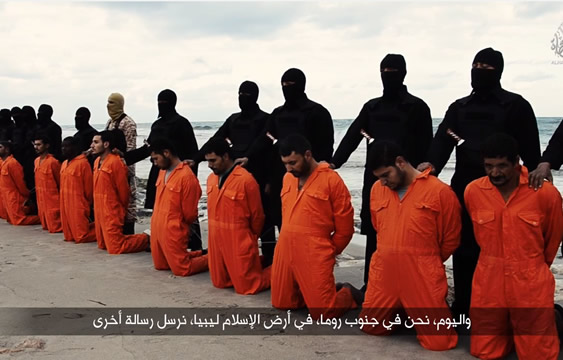
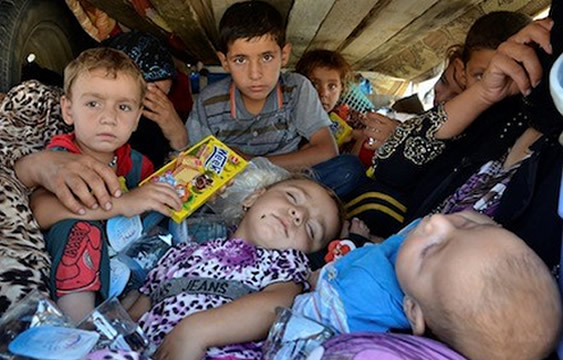
The vast majority of Iraqi and Syrian Christians are believed to have fled ISIS’s strongholds. Nonetheless, an estimated 625,000 to 775,000 Christians have remained in Iraq and Syria’s rural regions, perpetually in danger of ISIS activity nearby. Small numbers of Christians also reportedly remain inside key ISIS cities like Tal Afar and Raqqa, barred by ISIS from leaving. The effects of ISIS’s policy has devastated the Christian population in the Levant. Christians in Iraq went from a population of 1.4 million in 2003 to an estimated 150,000 to 275,000 in 2016. In neighboring Syria, Christians went from a population of 1.25 million in 2011 to 500,000 in 2016. (Sources: Forbes, Knights of Columbus p.222 & 223, Christian Times, Jerusalem Post)
ISIS militants in Libya have also slaughtered Christians. In May 2016, ISIS released a half-hour-long clip depicting the executions of 16 Ethiopian Christians in formerly ISIS-controlled territory in Libya. The militants described the Christians, who were filmed wearing orange jumpsuits, as “followers of the cross from the enemy Ethiopian Church,” before either shooting or beheading them. (Sources: Christianity Today, Express, Long War Journal)
Worldwide
ISIS has carried out a slew of deadly anti-Christian attacks in Egypt, which hosts the largest Christian population in the Middle East. On May 26, 2017, the first day of the Islamic holy month of Ramadan, gunmen opened fire on a bus of Coptic Christians in the southern Egyptian city of Minya, killing at least 29 people and wounding 25 others. ISIS claimed responsibility for the attack the following day, saying that a “security team of caliphate soldiers” had “set up an ambush” for the victims, who were on their way to visit a monastery south of Cairo. (Sources: Reuters, Los Angeles Times, New York Post)
The attack was the most recent of several ISIS-claimed attacks on Egypt’s Christian population. On April 9, 2017, ISIS carried out twin suicide bombings targeting Coptic Christians on the holy day of Palm Sunday, collectively killing at least 45 people and injuring dozens more. In the northern city of Tanta, one ISIS bomber detonated his suicide vest inside St. George’s church, killing 28 people. In another ISIS-claimed attack, a suicide bomber killed 17 people outside St. Mark’s church in Alexandria. ISIS had previously claimed responsibility for a suicide bomb attack targeting Coptic Christians in December 2016, when a bomber killed 29 people at the Saint Peter and Saint Paul Church in southern Cairo. ISIS said in a statement released after that attack that the group would “liberate” Cairo, threatening further attacks on Christians in the Middle East. (Sources: BBC News, New York Times, Los Angeles Times, Guardian)
ISIS also regularly calls for the killings of Christians and others in the West—often derided as “Crusaders”— through its various propaganda arms. On July 26, 2016, two ISIS sympathizers entered a Christian church in Normandy, France, taking nuns and worshipers hostage and killing the Catholic priest. Later that day, ISIS claimed responsibility for the church attack, asserting that its “soldiers” had acted “in a response to the call to target Crusader coalition states.” (Sources: New York Times, Daily Mail)

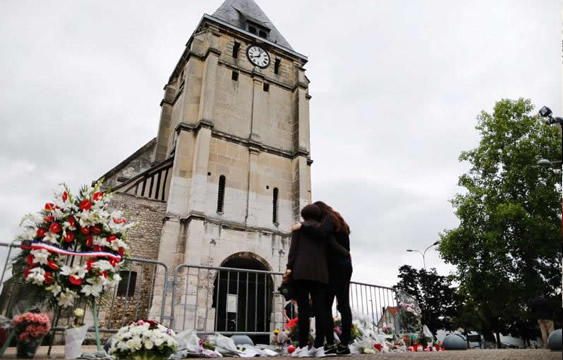
The attack in Normandy came after ISIS had repeatedly demonized and incited violence against Christians through its English-language magazine Dabiq. The magazine—itself named after the site of the final, apocalyptic battle between Christians and Muslims, according to Islamic eschatology—has published several issues dedicated to threatening the annihilation of Christians. Dabiq’s fourth issue, entitled “The Failed Crusade,” included a story asserting that “[e]very Muslim should get out of his house, find a crusader and kill him.” Former ISIS spokesman Abu Muhammad al-Adnani was quoted in the article urging readers to attack Westerners and Christians “wherever they can be found.” (Sources: International Business Times, BBC News, Dabiq, Huffington Post, Daily Mail, Tony Blair Faith Foundation)
In August 2016, ISIS released its 15th Dabiq issue, “Break the Cross.” In that issue, ISIS again attempted to discredit Christianity by labeling it as a “deviation” and a “falsehood that should be rejected.” ISIS used that issue to praise high-profile attacks in Florida, Bangladesh, France, and Germany, suggesting that in the wake of these attacks, “cross-worshipers [Christians]” and “democratic pagans of the West” should “consider… abandoning their infidelity and accepting Islam.” In a December 2016 online statement, ISIS published the names and addresses of thousands of churches in the United States and called on its followers to attack them. The statement encouraged ISIS sympathizers to “turn the Christian New Year into a bloody horror movie.” ISIS assailants carried out a deadly shooting attack on a Turkish nightclub on New Year’s Eve, killing 39 people. After it was revealed that the group had primarily killed Muslims, ISIS asserted that nightclubs were “temples of shirk [idolatry]” and that the attack was therefore religiously justified. (Sources: Dabiq, Daily Mail, Voactiv, Guardian, Rumiyah)
ISIS has continued to release anti-Christian propaganda and calling for attacks on Christians outside of ISIS-held territory. In May 2017, ISIS released the ninth issue of its online Rumiyah magazine, including a featured article attempting to provide religious justifications for the group’s deadly anti-Christian attacks in Egypt. In the article, ISIS referred to Christians as “fighters” and urged further attacks on churches and monasteries. (Source: Rumiyah)
Mandaeans
Out of a previous Iraqi-Mandaean population of around 10,000, only 1,000 remain.
ISIS has displaced an estimated 90 percent of the Gnostic Mandaean population in Iraq. An estimated 10,000 Mandaeans lived in Iraq’s northern provinces in 2014. By early 2016, an estimated 1,000 Mandaeans remain in Iraq, according to humanitarian aid group Noor Solidarity. (Sources: Week, Inter Press Service, Mandaean Associations Union, Noor Solidarity)
ISIS’s Territory
The majority of Iraq’s Mandaean community have been displaced from their homes in northern Iraq and forced to flee to nearby rural areas or neighboring countries, including Jordan, Turkey, and Iran. ISIS has threatened the Iraqi Mandaeans with “ethnic cleansing” and “extinction,” according to a 2014 statement by the Mandaean Association Union. (Sources: Mandaean Associations Union, Noor Solidarity, Inter Press Service, Week, Inter Press Service)
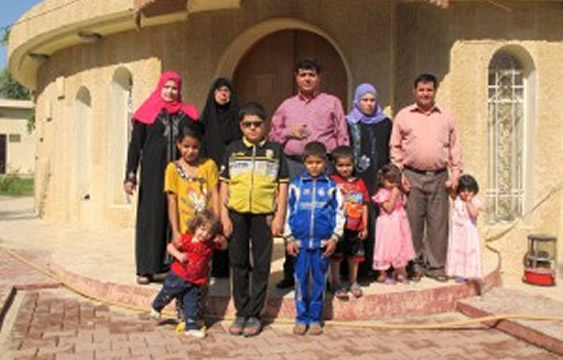
When ISIS captured Mosul in August 2014, Mandaeans there fled their homes out of fear that they would be killed or forced to convert. According to Suhaib Nashi, leader of the Mandaean Association Union in Exile, “Our community is suffering a real genocide at the hands of radical Islamists [ISIS].” Nashi claimed that ISIS militants were killing Mandaeans in order to appropriate their wealth and for “the more sinister reason of ethnically cleansing [us].” In the words of one Mandaean refugee, Mandaeans fear that going back to their homes “would be suicide.” (Sources: Minority Rights Group International, Inter Press Service)
Muslims
ISIS routinely targets and executes Shiites, Kurds, Shabaks, Sufis, and so-called apostates, denouncing them as kuffar (nonbelievers). Although ISIS typically calls for attacks on non-Muslims outside the Levant, the majority of the group’s victims are Muslims living in or near the so-called Islamic State. (Sources: Huffington Post, CNN, United Nations)
Shiites
ISIS regularly targets and massacres Shiites, the most populous Muslim sect in Iraq. In addition to killing thousands of Shiites and displacing hundreds of thousands more, ISIS uses its media arms to target, demonize, and incite violence against Shiites worldwide. (Sources: Independent, Front Page Mag, EPIC)
ISIS’s Territory
ISIS claims that Shiites adhere to a false form of Islam. The militants commonly refer to Shiite Muslims as “Rafidah,” a derogatory term that translates to “rejecters” (i.e. of Sunni Islam). In July 2016, after ISIS killed 175 people by bombing a predominantly Shiite neighborhood in Baghdad, the militants released a statement vowing that “The raids… against the Rafidha [Shiite] apostates will not stop.” (Sources: Independent, Huffington Post, Huffington Post)
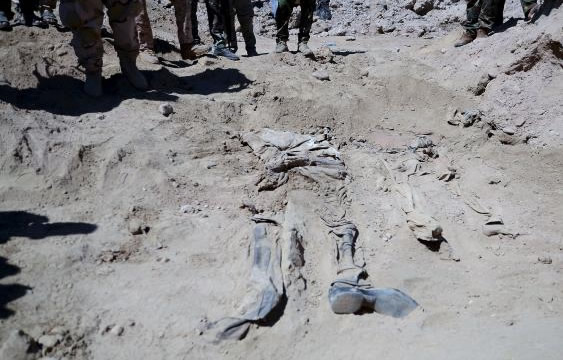
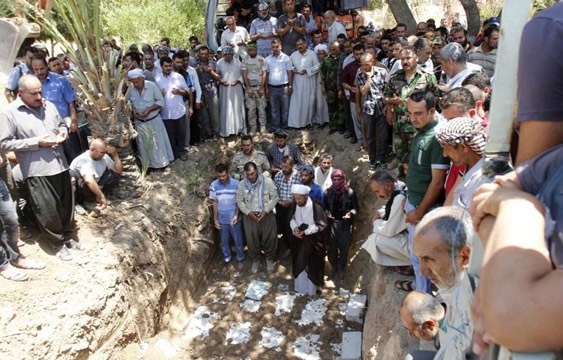
ISIS has conducted some of its most deadly attacks against Shiite populations in Iraq. On June 10, 2014, ISIS militants massacred 670 Shiite prisoners living in Badush, a town north of Mosul. Several days later, ISIS massacred 1,700 Iraqi Shiite air force recruits in Tikrit. Out of the nearly 19,000 civilians killed by ISIS in Iraq in 2014 and 2015, the majority are believed to be Shiite Muslims, according to a U.N. report. (Sources: Independent, Guardian, CNN, Independent, Independent, United Nations)
Worldwide
ISIS regularly publishes propaganda materials targeting Shiites worldwide. In January 2016, ISIS released its 13th issue of Dabiq magazine, titled “The Rafidah: From Ibn Saba’ to the Dajjal,” with one article claiming that ISIS will wipe out the entire global population of Shiites. The author asserts that Shiites are American allies, and that they “are mushrik [polytheist] apostates who must be killed wherever they are to be found, until no Rafidi [Shiite] walks on the face of earth.” (Sources: Dabiq, Fox News, Daily Mail, Fox News)
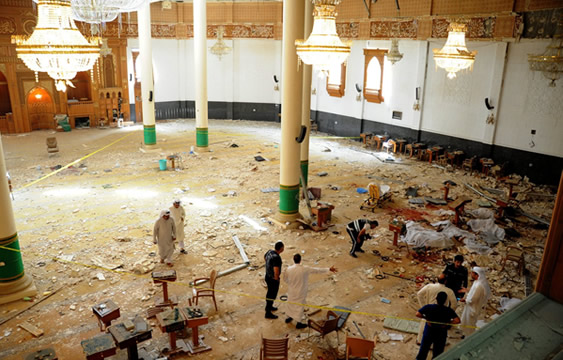

ISIS has claimed responsibility for attacks targeting Shiites outside of its territorial strongholds. In November 2015, for example, two ISIS militants detonated suicide bombs in Beirut, Lebanon, killing 43 people and wounding more than 230 others. ISIS later said that the group had specifically targeted the Bourj al-Barajneh neighborhood in southern Beirut because of its large Shiite population. (Sources: New York Times, Fox 8, CBS News, CNN, CNN, Diplomat)
ISIS has carried out attacks against Shiites and Shiite offshoots in Yemen, Saudi Arabia, and Kuwait. In March 2015, an ISIS-affiliated group claimed responsibility for suicide bombings targeting Zaidi mosques in Yemen, collectively killing more than 130 people. ISIS has since continued to carry out sectarian attacks in the Gulf region. In May 2015, ISIS carried out two suicide bomb attacks in Saudi Arabia, collectively killing at least 24 people and wounding an estimated 120 others. Also that month, ISIS claimed responsibility for a bomb attack at a Shiite mosque in Yemen, wounding at least 13 people. On June 26, 2015, an ISIS-affiliated suicide bomber targeted one of the largest Shiite mosques in the Kuwait, killing at least 25 people and wounding dozens more. (Source: New York Times, New York Times, New York Times)
ISIS has also carried out deadly attacks in Southeast Asia, targeting Shiite religious centers and gatherings in Bangladesh, Afghanistan and Pakistan. On November 26, 2015, ISIS-affiliated gunmen stormed a Shiite mosque in Bangladesh, opening fire on worshipers and killing one man, wounding three others. The attack came roughly a month after another set of bomb attacks in Bangladesh, which targeted a procession commemorating the Shiite holy day of Ashura. The attacks collectively left one person dead and dozens wounded. ISIS also claimed responsibility for the February 2017 bombing of a Sufi shrine in Pakistan. ISIS claimed responsibility for the attack, saying that the group had targeted a “Shia gathering,” though Sufi Muslims can adhere to Shiite or Sunni forms of Islam. ISIS has also claimed responsibility for the November 21, 2016, attack targeting a Shiite mosque in Kabul, Afghanistan, killing at least 30 people and wounding dozens more. ISIS claimed responsibility for the attack in a statement released by its Amaq news agency. (Sources: New York Times, New York Times, Independent, Independent, CNN)
Shabaks
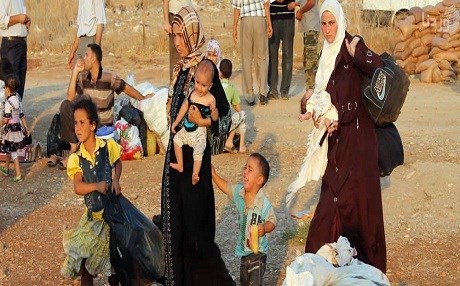
In 2014, Iraq was home to an estimated 450,000 Shabaks. Since then, 80 percent have reportedly fled north to Iraqi Kurdistan, with the rest scattering to Iraq’s rural regions. Shabaks are a non-sectarian, ethno-religious group indigenous to Iraq’s northern Nineveh province. Although Shabaks identify varyingly as Sunni or Shiite Muslims, ISIS considers them all apostates. (Sources: Kurdish Project, Human Rights Watch, Minority Rights Group International)
ISIS’s Territory
According to the International Organization for Human Rights (IOHR), nearly all Iraqi Shabaks have been displaced from Nineveh province. Human Rights Watch notes that the Shabaks have been “systematically killed and threatened” since ISIS captured Mosul in June 2014. (Sources: Human Rights Watch, Minority Rights Group International, Al Monitor, BBC News, Kurdish Project)
More than 3,000 Shabak families reportedly lost their homes and hundreds more were massacred when ISIS seized Mosul in June 2014. Although the majority of Shabaks managed to survive the advance of ISIS forces by fleeing to Kurdish territory in the north, an estimated 1,600 fell victim to ISIS kidnapping and killings. (Sources: Al-Monitor, Tony Blair Faith Foundation, Kurdish Project, New York Times, Human Rights Watch, Rudaw)
Alawites
ISIS considers the Alawite sect in Syria to be infidels and apostates. Alawites adhere to an offshoot of Shiite Islam and comprise 10 to 15 percent of Syria’s population, living mainly in the country’s western regions. ISIS, which associates the sect with the brutal regime of Syrian President Bashar al-Assad, has killed thousands of Alawites, including women and children. (Sources: BBC News, NPR, Wall Street Journal, Foreign Policy)
ISIS’s Territory
ISIS has promised to kill and displace the entire Alawite population in western Syria. According to the Syrian Observatory for Human Rights (SOHR), ISIS executed 120 Syrian regime soldiers in August 2014, when the militants captured the Tabqa airbase in Raqqa. ISIS has also targeted and murdered Alawite civilians, accusing them of collaborating with the regime. In February 2016, ISIS claimed a suicide bomb attack in the Syrian capital of Damascus that left eight people dead. Following the attack, ISIS released a statement online threatening further violence against Alawites: “Their [the Alawite] army will never feel secure and we will let them taste the killing and displacement that our people swallow in the land of Syria,” the statement read. (Source: Voactiv)
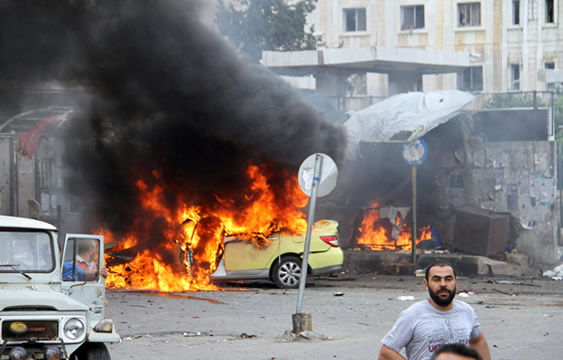
In July 2016, ISIS claimed that its fighters killed nearly 600 Syrian Alawites during the Islamic holy month of Ramadan (June 6, 2016 through July 5, 2016). On May 23, 2016, ISIS conducted a series of bombings in the Syrian coastal cities of Jablehand Tartus, killing nearly 150 people. ISIS later claimed responsibility for the attacks saying it “hit Alawite gatherings” in those cities. (Sources: Independent, Financial Times)
Sufis
ISIS has characterized the mystical Islamic practice of Sufism as idolatrous, singling out its adherents for attacks. ISIS began seizing territory from Sufi communities in northern Syria in March 2014 and in northern Iraq in June 2014. ISIS has since destroyed hundreds of Sufi shrines and religious sites. ISIS has also called for attacks against Sufis outside of its territorial strongholds. (Sources: BBC News, Huffington Post)
ISIS’s Territory
Soon after ISIS’s June 2014 takeover of Mosul, Iraq, the group began demolishing Sufi shrines, tombs, and mosques around the city. The practice has since continued within the so-called Islamic State and in its strongholds abroad. In March 2015, the militant’s media branch in Libya released photos of ISIS fighters razing Sufi shrines in the Tripoli province. In November 2016, an ISIS militant in Karachi, Pakistan, detonated a suicide bomb at a Sufi shrine outside of the city, killing at least 52 people and injuring more than 100 others. ISIS’s Amaq news agency claimed responsibility for the attack, which targeted more than 500 Sufis who had assembled at the shrine to perform a ritual. (Sources: Al Arabiya, Reuters, National Geographic, NewsDeeply, Al Jazeera, Daily Mail, CNN)
ISIS has also specifically targeted Sufi leaders. In late April 2015, humanitarian activist group Raqqa is Being Slaughtered Silently (RBSS) reported that ISIS had been targeting dozens of notable Sufi sheikhs in Raqqa for arrest or execution. Among those executed was Sheikh Hassan, the Imam of the Grand Mosque in Raqqa. (Source: Raqqa is Being Slaughtered Silently)
Worldwide

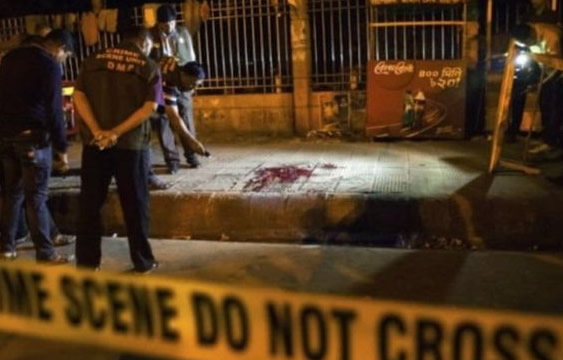
ISIS has called for and claimed attacks on Sufi leaders and gatherings abroad. On May 7, 2016, a suspected ISIS supporter hacked to death Sufi leader Mohammad Shahidullah in Bangladesh. ISIS has also called for the murder of American Shaykh Hisham Kabbani in its April 2016 issue of Dabiq. Kabbani, a Sufi leader from Detroit, had written a fatwa (religious ruling by an Islamic scholar) that declared that the Quran does not condone violent jihad, a statement that was distributed among U.S. troops in Iraq in 2011. Kabbani was named on a kill list in the magazine among other Western Muslim political figures from the United States and United Kingdom. (Sources: Daily Mail, Saisat Daily, Dabiq, Facebook, Hisham Kabbani)
On February 16, 2017, an ISIS-affiliated suicide bomber targeted the Sufi Lal Shahbaz Qalandar shrine in the historic city of Sehwan, Pakistan. The attack was the deadliest terrorist attack in Pakistan in two years, leaving more than 80 people dead and hundreds injured. ISIS claimed responsibility for the attack, saying that the group had targeted “Shia gathering” and calling the suicide bomber “a “martyr of the Islamic State.” Sufi Muslims can adhere to Shiite or Sunni forms of Islam. (Sources: Independent, Independent)
Apostates
ISIS has executed thousands of civilians and opposition soldiers under the pretext of apostasy. According to ISIS propaganda, any Muslim who resides outside of the so-called Islamic State and does not either travel to join the group or conduct domestic terror attacks is an apostate. Muslims within ISIS-held territory who resist the group or its laws are similarly deemed guilty of apostasy and sentenced to die. (Source: Dabiq)
ISIS’s Territory
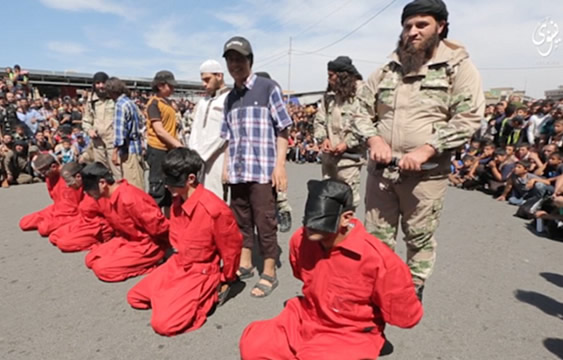
ISIS routinely labels its enemies as apostates, marking them for death. In January 2015, ISIS captured a group of 17 Syrian soldiers from the eastern province of Deir ez-Zor, labeling the men as apostates and crucifying them before finally shooting them to death. In May 2016, ISIS released a video depicting the execution of five men charged with apostasy. In October 2016, ISIS militants reportedly executed 58 of its own fighters accused of planning a rebellion in its stronghold of Mosul, Iraq. The conspirators were charged with apostasy and drowned. Their bodies were dumped in a mass grave outside the city. (Sources: Dabiq, Christian Post, Daily Mail, Heavy, Reuters)
Worldwide
ISIS produces propaganda advocating for the murder of so-called apostates worldwide. ISIS’s 14th issue of Dabiq—released in April 2016—included an article claiming that imams in West continue to “poison” the minds of their students with ideas of “liberalism and democracy.” The article singled out Muslim-American scholars for allegedly teaching “half-truths and false interpretations” regarding Islam. “Real” Muslims, according to ISIS, must move to the so-called Islamic State or wage jihad abroad to kill “disbelievers and apostates.” The article asserted that a Muslim—regardless of where he or she lives—is not a true Muslim unless he or she shares ISIS’s ideology and supports the group as a foreign fighter or domestic terrorist. (Source: Dabiq)
ISIS has to that end issued a ‘kill list’ of Western Muslim political figures, including American and British politicians and other “politically active apostates.” ISIS has even singled out competing Islamist groups as apostates, even labeling Egyptian-based Islamist group Muslim Brotherhood and its affiliates abroad as a “cancer” to Islam. (Sources: Dabiq, Tony Blair Faith Foundation)
The Vilification of Other Religious Groups
ISIS incites, executes, and celebrates attacks against religious groups that reside outside of its territorial strongholds. On various occasions, ISIS has expressed its desire to target Jews and Hindus in particular, and professed its aims to eradicate the state of Israel and conquer India.
Jews
God has gathered you [Jews] in Palestine so that the Mujahadeen can reach you soon and you will hide by the rock and the tree. Palestine will be your graveyard.Abu Bakr al-Baghdadi, December 26, 2015
ISIS has sought to incite attacks against Jews around the world and has vowed to turn Israel into a “graveyard.” (Sources: Anti-Defamation League, VICE)
Worldwide
In September 2014, former ISIS spokesman Abu Muhammad al-Adnani released a video in which he blamed Jews for organizing the international coalition against ISIS. In that speech, Adnani called for attacks against Western soldiers and civilians, and calling U.S. President Barack Obama a “mule of the Jews.” Adnani said, “The Jews! The Jews! Save the Jews!’ This is the reason they [the U.S.-led coalition] came.” ISIS supporters have also urged anti-Semitic attacks. In one post from February 2017, ISIS supporters on Telegram urged fanatics to “dress up like a Jew” and “terrorise the Yahood [Jew].” (Sources: Anti-Defamation League, Daily Mail)

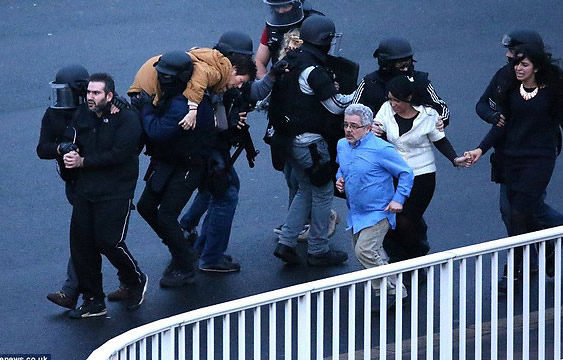
ISIS has been successful in carrying out attacks on Jewish targets worldwide. In March 2016, a suspected ISIS suicide bomber killed three Israeli tourists outside of their hotel in Istanbul, Turkey. The attack came soon after the ISIS newsletter Al-Naba published an article commanding attacks on Jews worldwide. ISIS said that attacking Jews is the duty of every Muslim and urged supporters to attack “Jews and their allies where ever [you] may find them.” That same month, Turkish intelligence officers uncovered an ISIS plot to attack Jewish schools Istanbul. (Sources: Jerusalem Post, Fox News)
In October 2015, U.S. citizen and ISIS sympathizer Mahin Khan reportedly told an undercover FBI agent that he intended to detonate a pressure cooker bomb outside of a Jewish community center in Arizona. In January 2015, Frenchman Amedy Coulibaly recorded a video in which he pledged allegiance to ISIS before he raided kosher food store and killed four people—all of them Jews—after taking multiple people hostage. In May 2014, Mehdi Nemmouche, who had spent a year in Syria fighting for ISIS, killed four people and wounded another in a shooting at a Jewish Museum in Brussels. (Sources: ABC15, Breaking Israel News, Anti-Defamation League, Wall Street Journal)
ISIS was also found to have specifically targeted Jews during the March 2016 Brussels attacks, particularly at Brussels airport. According to sources close to the investigation, Jews traveling to Israel were targeted in particular. Bomber Najim Laachraoui allegedly followed a group of Hasidic Jews in the airport before detonating his device, according to the Belgian source. The source said that Laachraoui “seemed to rush towards two Orthodox Jews. He really, clearly wanted to kill a Jew.” (Source: Newsweek)
Hindus
ISIS has vowed to make India a part of its so-called Islamic State. The group has called for the mass killings of Hindus worldwide, and has vowed to provoke the Armageddon by organizing a largescale attack on India. (Sources: Dabiq, Firstpost, Daily Mail)
Worldwide
In a May 2016 online video, ISIS encouraged Indian Muslims to travel to the “Caliphate” or else attack Hindus within India. The video depicted an Indian foreign fighter in Syria declaring, “In [ISIS’s] land you get to have hatred for the kuffar [infidels]. In this land you get to perform jihad.” In the video another fighter claims, “We will come back, with the sword, to free you [Muslims], [and] to avenge” anti-Muslim riots in India, including the 1992 burning of the Babri mosque in northeast India, and the 2002 riots in Gujarat and Kashmir, attacks that collectively left nearly 1,000 people dead. (Source: Independent)
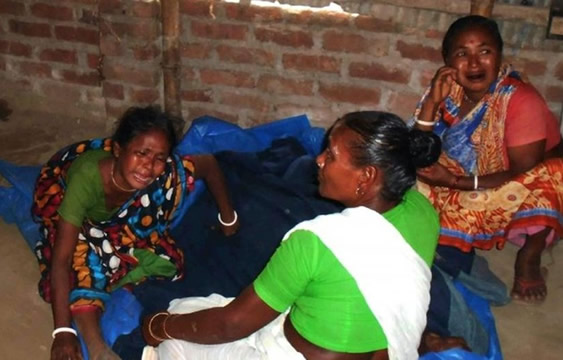

ISIS has claimed responsibility for the majority of at least 30 murders of religious minorities, liberal bloggers, and academics in Bangladesh in 2015 and 2016. In the group’s April 2016 issue of Dabiq, ISIS published an interview with “Abu Ibrahim al-Hanif,” ISIS’s former representative in Bangladesh. Hanif claimed that he was training fighters in Bangladesh and Pakistan to launch suicide attacks in India and rid the country of Hindus. “We will target Hindus in large numbers,” said Hanif. (Sources: Independent, Dabiq, Firstpost, One India)
ISIS is also suspected behind several terrorist plots and attacks in India. In March 2017, two bombs exploded a train in the northern Indian city of Agra, wounding 10 people. The attack—believed to have been carried out by ISIS—came days after ISIS threatened to carry out attacks on the Taj Mahal mausoleum in Agra. India has also arrested suspected ISIS assailants. In October 2016, authorities arrested members of a suspected ISIS cell that had allegedly been plotting attacks during the Hindu festival of Diwali. (Sources: Times, Newsweek, Newsweek)
ISIS has also attempted to capitalize on anti-Hindu sentiment in Southeast Asia, promising to attack India in order to bring about “the end of the world.” In July 2015, ISIS distributed a propaganda pamphlet in Afghanistan and Pakistan seeking to recruit Taliban and al-Qaeda fighters. The document revealed ISIS’s aspirations to unite the Taliban, al-Qaeda, and ISIS under one army and trigger all-out war by attacking India and provoking the United States to intervene. (Source: Daily Mail)
Conclusion
ISIS demonizes, threatens, and persecutes members of different religious groups, both within its so-called Islamic State and beyond. Among those attacked and persecuted within ISIS-controlled territory are Yazidis, Christians, Mandaeans, Shiites, Shabaks, Alawites, Sufis, and so-called apostates. ISIS also attempts to vilify and target Jews and Hindus outside of the group’s controlled territories, denouncing them as sinners and enemies of Islam in attempt to harvest additional support from prospective recruits abroad.
ISIS maintains that non-Muslims must convert to Islam or die. Notably, however, the militants have committed some of their most violent and deadly attacks against other Muslims—including Shiites, Shabaks, Alawites, and Sufis, as well as secular or dissident Sunnis—whom the group labels as apostates.
ISIS’s extremist ideology requires all religions to embrace the group’s radical and perverse ideology, or else face persecution, abuse, torture and death. Backed by its violent actions and rhetoric, ISIS has repeatedly shown that no faith group—including and particularly the Christians, Yazidis, and Muslims in ISIS’s immediate warpath—is safe from the group’s extremist ideology.